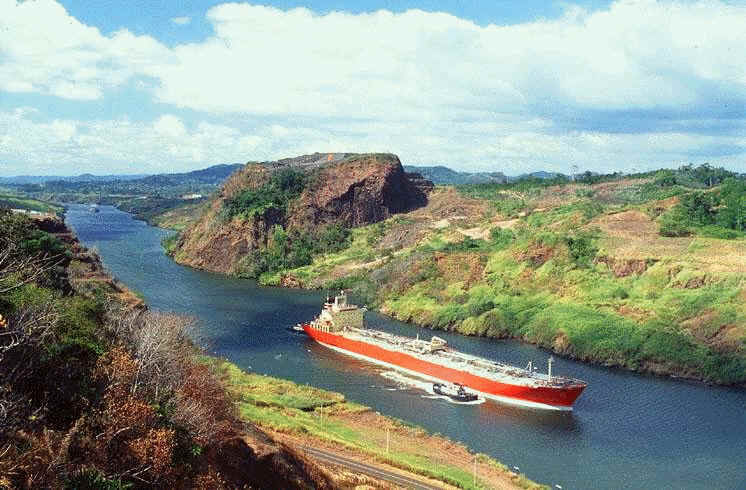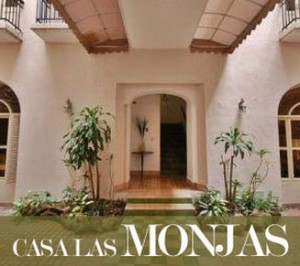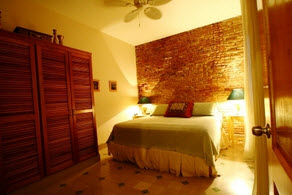This week has been busy having just returned from Pedasi only to have to fly off to Panama City to meet with a client coming in to look at a large renovation project. I opted to stay close to the property and this was the second time I have stayed in Casco Viejo or Casco Antiguo as it is known. I now see no reason to stay anywhere else when I visit the City. While the high rise hotels and casinos are fun once or twice, Casco is what Panama is all about. I spent the evening in Plaza Bolivar where there are a number of restaurants and bars but the special time was sitting outside with a clear sky, cool breeze and a guitarist playing and singing classic ballads. The WOW factor kicked in and I was in heaven dreaming back to the days when I visited Spain and other cities that have real character and history, not to mention incredible local flavor.
In the beginning of 1998. Casco Viejo was recognized by UNESCO and the United Nations for Education, Science and Culture as a site of world interest, due to the physical and universal aspects of this historical location. The buildings that line the wide, brick street streets of Casco Viejo, many of which have expansive balconies, reflect Panama’s rich architectural styles and diverse cultures. Casco Viejo is the focal point of Panamanian architectural history, with it’s picturesque buildings, wide streets comprised of red bricks, churches, ruins and museums. It is here, together, where the identity of Panama City and it’s people is best illustrated.




I found a place to stay that was within a block of Plaza Bolivar that is operated by some friends of mine, Evan Forbes and Matt Landau. Los Cuatro Tulipanes consists of several renovated buildings including Las Monjas where I stayed. Evan told me that it was once a nunnery and the old brickwork was incorporated into the final design like a lot of buildings in Casco. Matt and Evan live in Casco and are experts in the area. They are generating a good return for the investors who have bought the units that are rented out. I saw several opportunities that are still attractively priced despite the run up in prices. It takes a lot of work and many newbie’s come and go after giving up working through the process of renovating in a historic district such as this. In the end though, a property in Casco is a “must have” in any investment portfolio here in Panama.
Before I leave this I wanted to publish an article I read in El Casqueno that speaks of how special this place really is. Patrizia Pinzon speaks from the heart and owns one of the most dynamic companies in Casco besides working in numerous other social activities. I caught her this morning teaching balet to 2 and 3 year olds and enjoyed chatting with her about life in Casco.
A New Way from the Old Quarter?
Below is a reprint of an article written by Patrizia Pinzón for The Visitor in July 2010, it’s too well written to only have been in circulation for one week so here it is to live on in the internet forever…
Like many developing countries, Panama is working to apply the fashionable terms “sustainable” and “socially conscious” to its growing tourism industry. Whether we are successful or not will only be clear many years from now, but in at least one nook of the country things are looking promising.
Strolling along 300-year-old Avenida A between Fourth and Fifth Streets of Casco Antiguo a sharp eyed traveler may notice the humble hand-cut metal sign that reads “VIP” next to an oversized, fruit-filled open window. While the attention of a mere tourist would be immediately drawn to the jewelry store across the street, the seasoned traveler will instinctively know that a window like this in a neighborhood like Casco Antiguo holds the promise of the traveler’s holy grail: the authentic and unexpected.

The traveler would be rewarded to find that leaning on the counter facing this narrow cobbled street is Mary, a local entrepreneur, who, for a dollar, will make what most residents in this neighborhood–rich and poor alike–claim are the best fruit smoothies in Panama. Next door to Mary, a small chalkboard announces Bohemios, a startlingly tasty restaurant co-owned by Niko, the ex-leader of a now defunct street gang that until two years ago called Fourth Street its home. Next to Niko, Doña Daisy, an aging seamstress, sells her hand-made children’s clothing.
All of these businesses operate out of shops made available at deeply subsidized rents by a local landlord who believes that the long term gain to the neighborhood of allowing local residents to build their own businesses is worth foregoing some short term revenues it might generate from higher paying tenants; like a jewelry shop.
At the corner of Avenue A and Fifth Street, the high-end traveler would find Julia, Yasmina, Augustina and Dayanara attending to guests at the Canal House, an up-scale boutique hotel that prides itself on exclusively hiring staff from the neighborhood trained by a local foundation that helps unemployed women. When the hotel was named “Editors’ Pick” by the New York Times, Manager Thelma Bodden credited the staff’s “warmth and dedication” as what “makes our hotel.”

All along these streets, ubiquitous balconies combine for an operatic setting in which one could imagine the Three Tenors stepping out to render an aria. But it is an article of faith among even the most hardened businessmen who live here that without kids in the streets, old-timers lounging in the parks, affordable housing for the working class, and, yes, laundry hanging over some of those balconies, Casco Antiguo would be Disney-fied like so many other historic districts that have kept their shells but lost their souls.

A little more digging around Fourth Street would reveal to an especially curious traveler an old girls school, now converted into a privately run community center where an afterschool program helps kids learn computers and a handful of community organizations provide training and counseling to residents. Further down Avenue A, legendary jazz pianist Danilo Perez runs a music school that has a provided local kids with scholarships to Berkelee School of Music and local establishments with top-flight live acts.
The kaleidoscope of causes and organizations has one common denominator: they are funded almost entirely by a growing community of businesses and new residents of the Casco with a deep social commitment. Collectively, they are the result of an inclusive vision that recognizes the value of the historic district not just for its architectural heritage, but also in its human heritage. A special feature of this collective social responsibility is its emphasis on teaching, on providing opportunities for personal and professional growth rather than doling out charity.
An ecosystem involving all the community’s elements, it strives to break with prejudices about social and economic mix. It is particularly determined to break the image of an architectural museum; to re-invent the Casco as a living city in which all can have a productive role.
Seemingly almost as a side effect but certainly not insignificantly, this movement is coming to define a tourism destination more interesting to the press and foreign visitors who value and seek authentic experience. History seems to be repeating itself: More than three hundred years Casco Antiguo was a seed that germinated two centuries later into the Republic of Panama. Today, the Old Town seems once again a seed for change.
Panama’s tropical paradise a ‘hub of biodiversity’
When I first came to Panama, I woke up after a full day of traveling with a cup of Boquete coffee and was greeted by a spectacular looking hummingbird that flew up to look me eye to eye no more than a foot from my face. Later that morning a blue morpho butterfly did the same thing and I began to think I had found paradise indeed here in Boquete. After 4 years here now, I have come to realize that I am only beginning to appreciate the beauty and the biodiversity of this wonderful country. Here is a CNN article that just came out.



A hotbed of biodiversity, Panama’s tropical habitats are home to some of the most diverse and exotic species of plants and animals on Earth.
Covering almost half the country’s land surface are immense tracks of rainforests, mangrove wetlands and mountain cloud forests.
Even the country’s cosmopolitan capital of Panama City boasts a forest within its city boundaries — one of the last tropical dry forests in Central America.
In all, the country houses over 10,444 different types of plant species including 1,200 orchid varieties, 678 fern species and 1,500 varieties of trees. As well as 255 species of mammals and 972 indigenous bird species, according to the National Society for the Protection of Nature, Panama. Read more here………..
OK, on to some good press on Panama for this week
Panama’s President Ricardo Martinelli on Fox News
I saw this on Don Winner’s Panama Guide and find his comments on point.
By DON WINNER for Panama-Guide.com – Panama’s economy continues to grow at an impressive pace, to the point where Neil Cavuto asked Panamanian President Ricardo Martinelli if he would be willing to give some advice on fundamental economic principals to Barack Obama. I had not realized that Martinelli has seven CEO’s on his cabinet (and Obama has none.) Boy, does that explain a bunch of stuff….
Panama’s economy grows 6.3 pct in 2nd quarter
It is no secret that Panama is continuing to grow even in these trying times and another article came out in Reuters acknowledging the facts.


PANAMA CITY (Reuters) – Panama’s economy grew 6.3percent in the second quarter versus the same period a yearago, the government said Wednesday. Panama posted strong gains across many sectors in thesecond quarter, including banking, tourism and constructionboosted by the $5.25 billion expansion of the Panama Canal. The Central American country’s economy has been one of thestrongest performers in Latin America in recent years,withstanding the global economic downturn with a 2.4 percentexpansion in 2009. The government and analysts expect Panama’s economy toexpand at least 5 percent this year In spite of slight declines in traffic through the canal,the country’s gross domestic product could grow 6.3 percentthis year and 6.9 percent in 2011, according to a projection byBarclays Capital. “The Panamanian economy continues to perform stronglybecause of an increase in private and public consumption andinvestment, making the country less vulnerable to a slowerrecovery in the global economy,” Barclays said in a reportWednesday. (Reporting by Sean Mattson; editing by Carol Bishopric)
Latin America Avoiding US Double Dip
Whether the US falls into a double dip recession or not is a continuing debate but it appears that Latin America will again avoid the brunt of it should it happen as reported in the Latin American Advisor
Latin America — led by Brazil, Peru, Argentina and Chile — should avoid the brunt of any potential US double dip recession.
Inter-American Dialogue
Investors were rattled in the past month by disappointing economic news in the United States, including a record low for new-home buying and weaker-than-expected demand for durable goods. Meantime, Brazil’s pace of job creation has been slowing, and while Mexico’s foreign direct investment increased in this year’s first half, retail sales there slid in June from May. Where does Latin America’s economic recovery stand? Is there a chance for a double-dip recession? Which countries are seeing the most sustainable growth and where is the recovery on shakier ground?
Here are some summary comments from the experts


Rogelio Ramírez de la O, president of Ecanal in Mexico City: Latin America suffered little from the Great Recession in 2009, with the region’s GDP contracting 1.8 percent last year and growing again this year. The outlook for 2011 is still promising, though it would most likely be slower growth than at the 2010 peak, owing to a less favorable external environment.
Gabriel Torres, sovereign risk analyst at Moody’s Investors Service in New York: Generally speaking, Latin America’s growth this year looks solid, but with clear regional differences. South America’s commodity exporters look set to be the fastest growing of all, as demand and prices for their main products remain high.
Joydeep Mukherji, senior director of Latin American Sovereign Ratings at Standard & Poor’s in New York: S&P does not expect a double-dip recession in the United States. We forecast U.S. economic growth of 2.5 percent to 3 percent in 2011. Hence, Latin America should continue to enjoy good economic performance. The GDP-weighted growth rate for the region may exceed 6 percent in 2010, and be around 4.5 percent next year.
That’s it for this week and I hope you are considering a visit in the near future to see this wonderful country.
Time to chill and hang out at the pool, wait what do you mean that I have changed since coming to Panama!!




